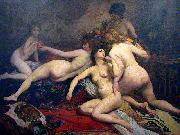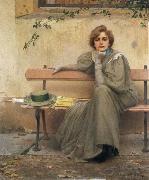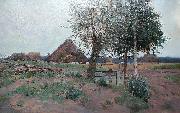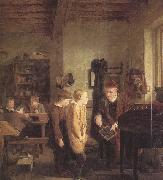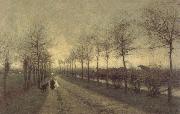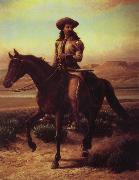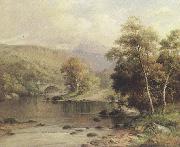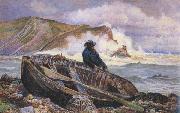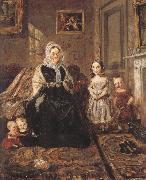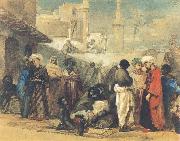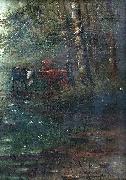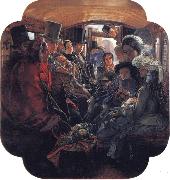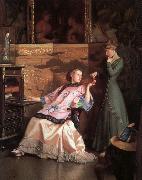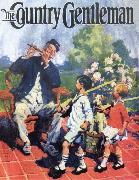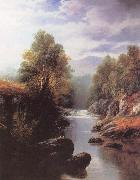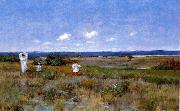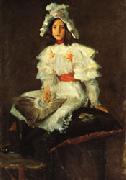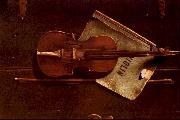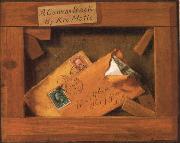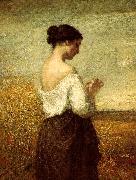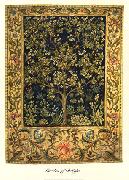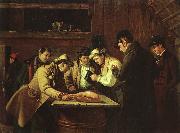|
|
|
|
|
|
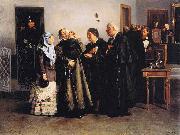 |
Vladimir Makovsky
|
|
(Russian: 26 January (greg.: 7 February) 1846, Moscow - 21 February 1920, Petrograd) was a Russian painter, art collector, and teacher.
Portrait by Vladimir Makovsky of Empress Maria Fyodorovna. Gatchina Palace, 1885Makovsky was the son of collector, Yegor Ivanovich Makovsky, who was one of the founders of the Moscow Art School. Vladimir had two brothers, Nikolai Makovsky and Konstantin Makovsky, and one sister, Alexandra Makovsky, all of whom were famous painters. Vladimir studied at the Moscow School of Painting, Sculpture, and Architecture. He finished his studies in 1869 and the following year became one of the founding members of the Association of Travelling Art Exhibitions, where his many years of prolific work brought him to a leading position
Makovsky's work was defined by a perpetual humor as well as blatant irony and scorn. During the seventies his paintings dealt primarily with small-town folk. His pictures, "The Grape-juice Seller" (1879), "Fruit-Preserving" (1876) and "The Congratulator" (1878) depict various scenes where the mood is finely conceived and almost laughter-inducing. Other works of his, such as "The Benefactor" (1874) and "The Convict" (1878) are profoundly socially-conscious. In them, Makovsky either criticizes the false sympathy of the aristocracy towards the poor, or draws attention to the oppression and persecution by the tsarist gendarmerie. In 1878, he became an academician.
In the eighties, during the time of Russian "democratic" painting, Makovsky produced some of his most valued works. In 1882, he was made professor at the Moscow Art School after the death of Vasili Perov. Some of Makovsky's greatest works of this period include "In the Ante-room of the Court of Conciliation" (1880), "The Released Prisoner" (1882), and "The Collapse of the Bank" (1881). From the end of the 1880s, Makovsky began to produce more gloomy works. Quintessential works of this period include "You Shall Not Go" (1892), and "On the Boulevard" (1888).
In 1894, Makovsky became Rector of the Preparatory school of the Academy of Art. After the First Russian Revolution, he painted "January 9, 1905, on Vasilyev Island" in which he depicts the armed police firing at defenseless people. In another painting "The Sacrifices on the Khodyn Field" in which a thousand people lost their lives during the coronation ceremony in 1896 of Nicholas II, he again stood uncompromisingly on the side of the oppressed people. After the 1917 October Revolution, Makovsky helped carry over the realist traditions to the early stages of Socialist Realism.
|
|
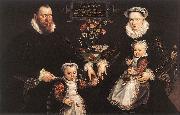 |
VOS, Marten de
|
|
Flemish painter (b. 1532, Antwerpen, d. 1603, Antwerpen). |
|
|
|
|
|
|
|
 |
Wilhelm Marstrand
|
|
(24 December 1810 - 25 March 1873), painter and illustrator, was born in Copenhagen, Denmark to Nicolai Jacob Marstrand, instrument maker and inventor, and Petra Othilia Smith. Marstrand is one of the most renowned artists belonging to the Golden Age of Danish Painting.
Marstrand studied at Copenhagen's Metropolitan School (Metropolitanskolen), but had little interest in books, and left around 16 years of age. Christoffer Wilhelm Eckersberg, painter and professor at the Royal Danish Academy of Art (Det Kongelige Danske Kunstakademi) in Copenhagen, was a close friend of Wilhelm's father, and it was to all appearance Eckersberg who recommended an artistic career for young Wilhelm. Wilhelm had already shown artistic talent, tackling difficult subjects such as group scenes with many figures and complicated composition.
At 16 years of age Marstrand thus began his studies at the Academy under Eckersberg, attending the school from 1826 to 1833. Although his interests had a firm hold in genre themes - depiction of the daily life he observed around him in Copenhagen's streets, especially middle class society - he would soon reach for the pinnacle of Academic acceptability: the history painting.
History painting displayed what was grand - classical themes from mythology and history, rather than daily life. The traditions, and the taste of traditional art critics, strongly favored it. It was therefore something to strive for, in spite of Marstrand's equal skill at depicting more modest themes, and of the enjoyment he had in portraying the crowds, the diversions of the city, and the humor and story behind the hustle and bustle. Marstrand's creative production would, through many paintings and illustrations made not only during the 1830s but throughout his life, never abandon this inclination toward displaying the simple life of his times.
At the same time Christian Waagepetersen, wine merchant to the Danish court and supporter of the arts, also became an important patron for Marstrand during this early period. His painting "A musical evening party" (Et musikalsk aftenselskab) (1834), depicts such an occasion at the home of Waagepetersen, and was an important transition painting for Marstrand.
Despite an unmistakably growing recognition, Marstrand never received the Academy's gold medal. This medal was coveted not only for its great prestige, but also because it came with a travel stipend for furthering the laureate's artistic training. Marstrand's attempts at winning the medal were unsuccessful both in 1833 with his neoclassical "Flight to Egypt" (Flugten til Ægypten) and in 1835 with "Odysseus and Nausikaa". This was a disappointment, as he had won both available silver medals in 1833.
|
|
|
|
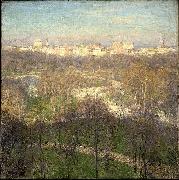 |
Willard Leroy Metcalf
|
|
(July 1, 1858 - March 9, 1925) was an American artist born in Lowell, Massachusetts. He studied at the School of the Museum of Fine Arts, Boston, and later attended Academie Julian, Paris. After early figure-painting and illustration, he became prominent as a landscape painter. He was one of the Ten American Painters who in 1897 seceded from the Society of American Artists. For some years he was an instructor in the Womans Art School, Cooper Union, New York, and in the Art Students League, New York. In 1893 he became a member of the American Watercolor Society, |
|
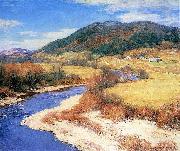 |
Willard Metcalf
|
|
Willard Leroy Metcalf (July 1, 1858 - March 9, 1925) was an American artist born in Lowell, Massachusetts. He studied at the School of the Museum of Fine Arts, Boston, and later attended Academie Julian, Paris. After early figure-painting and illustration, he became prominent as a landscape painter. He was one of the Ten American Painters who in 1897 seceded from the Society of American Artists. For some years he was an instructor in the Womans Art School, Cooper Union, New York, and in the Art Students League, New York. In 1893 he became a member of the American Watercolor Society, New York. Generally associated with American Impressionism, he is also remembered for his New England landscapes and involvement with the artists' colony at Old Lyme, Connecticut.
Born into a working-class family, Metcalf began painting in 1874. In 1876 he opened a studio in Boston, and received a scholarship at the Boston Museum school, where he studied until 1878. In 1882 he held an exhibition at the J. Eastman Chase Gallery in Boston, the sales from which financed a study trip abroad.[1]
Metcalf left for Europe in September 1883, and did not return to the United States until late 1888. During that time he traveled and painted, studying first in Paris with Gustave Boulanger and Jules-Joseph Lefebvre, subsequently going to England and Pont-Aven, Brittany. In the winter of 1884 he apparently met John Twachtman in Paris, and painted at Grez-sur-Loing alongside other American artists, including Theodore Robinson. His landscapes at this time were traditional renditions of peasant scenes, in the manner of Jean Millet.[2] By 1886 Metcalf was painting in Giverny, evidently the first American painter to visit there.[2] Soon thereafter he traveled to Algeria and Tunisia, returning to Giverny in the summers of 1887 and 1888, in the company of other American painters.
|
|
|
|
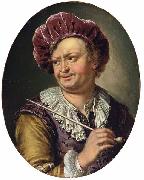 |
Willem van Mieris
|
|
(3 June 1662, Leiden - 26 January 1747, Leiden) was a Dutch painter. He was a son of Frans van Mieris sr. and brother of Jan van Mieris.
His works are extremely numerous, being partly imitations of the paternal subjects, or mythological episodes, which Frans habitually avoided. In no case did he come near the excellence of his sire.
van Mieris has works in the Victoria and Albert Museum as well as Cheltenham and Derby Museum and Art Gallery
|
|
|
|
|
|
|
|
|
|
|
|
 |
William J. McCloskey
|
|
painted Lady Apples in Overturned Basket. Signed W.J. McCloskey in 1941
United States (1859- 1941 ) - Painter |
|
|
|
|
|
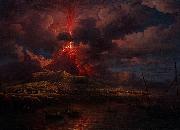 |
William Marlow
|
|
(1740 - 14 January 1813) was a British landscape and marine painter and etcher.
Marlow was born in Southwark in London, and studied for 5 years under the marine painter Samuel Scott, and also at the St. Martin's Lane Academy, London.
He became a member of the Incorporated Society of Artists, and from 1762 to 1764 contributed to their exhibitions in Spring Gardens. He was employed in painting views of country houses.
From 1765 to 1768, on the advice of the Duchess of Northumberland, he travelled in France and Italy. On his return to Britain he renewed his contributions to the Society of Artists, and took up residence in Leicester Square, London - he was made a Fellow of the Society in 1771.
In 1788 he moved to Twickenham, and started to exhibit at the Royal Academy, showing works regularly until 1796, and again, for the last time, in 1807, when he exhibited Twickenham Ferry by Moonlight.
Marlow died in Twickenham on 14 January 1813.
|
|
|
|
|
|
|
|
|
|
|
|
|
|
|
|
|
|
|
|
|
|
|
|
|
|
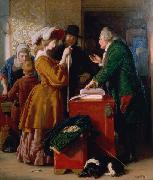 |
William Mulready
|
|
(1 April 1786 - 7 July 1863) was an Irish genre painter living in London. He is best known for his romanticizing depictions of rural scenes, and for creating Mulready stationery letter sheets, issued at the same time as the Penny Black postage stamp.
William Mulready was born in Ennis, County Clare. Early in his life, in 1792, the family moved to London, where he was able to get an education and was taught painting well enough so that he was accepted at the Royal Academy School at the age of fourteen.
Choosing the Wedding Gown
illustrating ch 1 of Vicar of Wakefield by Oliver GoldsmithIn 1802, he married Elizabeth Varley (1784-1864), a landscape painter. Their three children, Paul Augustus (1805-1864), William (1805-1878), and Michael (1807-1889) also became artists. His relationship with his wife however deteriorated gradually over the years, which is detailed in papers stored at the library of the Victoria and Albert Museum. His strong Catholic beliefs prevented any chance of a divorce but they separated. He accused her of "bad conduct" but shied from providing details. In a letter to him in 1827 she blamed him entirely for the collapse of their marriage, suggesting cruelty, pederastic activities and adultery were the reasons.
His son, William Mulready Junior (1805-1878), lived in London and maintained a career of a portrait painter and picture restorer. He had five children (Ellen, Mary, Augustus Edwin, Henry William, and John).They also were trained as artists, but not all of them pursued the artistic career: Henry William and John described themselves as 'house painters'. Augustus Edwin Mulready (1844-1904) was the most successful of them and became known as a member of the Cranbrook Colony of artists.
|
|
|
|
|
|
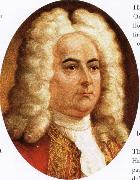 |
wolfgang amadeus mozart
|
|
Born: 27 January 1756
Birthplace: Salzburg, Austria
Died: 5 December 1791 (fever)
Best Known As: Composer of Eine kleine Nachtmusik |
|
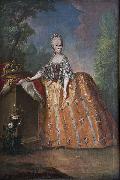 |
Workshop of Anton von Maron
|
|
Anton von Maron (January 8, 1733 - March 3, 1808) was an Austrian painter, active in Rome.
Von Maron was born in Vienna, but moved at a young age to Rome. There, he studied under Anton Raphael Mengs, and became an accomplished portrait painter. He married a sister of Mengs, Therese Maron, who was a painter in her own right. He lived the rest of his life in Rome, and died there in 1808. |
|
|
|
|







